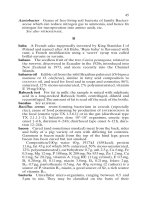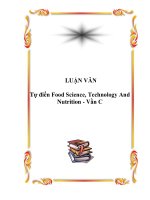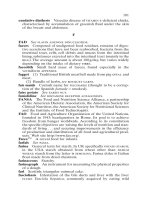Interrelation between cloud computing technology and agriculture fields
Bạn đang xem bản rút gọn của tài liệu. Xem và tải ngay bản đầy đủ của tài liệu tại đây (653.15 KB, 9 trang )
Int.J.Curr.Microbiol.App.Sci (2019) 8(1): 2991-2999
International Journal of Current Microbiology and Applied Sciences
ISSN: 2319-7706 Volume 8 Number 01 (2019)
Journal homepage:
Review Article
/>
Interrelation between Cloud Computing Technology and Agriculture Fields
Deepak Indoria1 and Deepa Indoria2*
1
Yagvalkya Institute of Technology, RTU, Kota, Rajasthan, India
2
Krishi Vigyan Kendra, Chittorgarh, Rajasthan, India
*Corresponding author
ABSTRACT
Keywords
Cloud computing,
Community model,
Hybrid model,
Public model,
Private model,
Agriculture, IaaS,
Paas & SaaS
Article Info
Accepted:
20 December 2018
Available Online:
10 January 2019
Cloud computing is an architecture for facilitating computing service through the internet
on requirement and pay per user access to a group of shared resources namely networks,
storage, servers, services and applications, without physically acquiring them Cloud
DBMS is a distributed database that gives computing as a service. It is sharing of web
infrastructure for resources, software and information over a network. The cloud is used as
a storage location and database can be accessed and computed from anywhere. In this
paper I have discussed about cloud and its use. How we can implement cloud for better
performance and different benefits and drawbacks of cloud which we can improve in
future Use of Cloud computing technology in agricultural areas has greater chance in the
overall development of India. An effective implementation of cloud computing is
encouraging in agricultural sector. Cloud Computing is emerging today as a commercial
infrastructure that eliminates the need for maintaining expensive computing hardware,
software, Information technology, staff, infrastructure, recourses and their maintenance.
Cloud computing is a network-based environment that focuses on sharing computations,
Cloud computing networks access to a shared pool of configurable networks, servers,
storage, service, applications & other important computing resources. In modern era of
cloud computing technology very helpful for centralized the all-agricultural related data
bank (Soil-related, weather, Research, Crop, Farmers, Agriculture marketing, fertilizers
and pesticide information) in the cloud. In this paper, also discuss Computing model,
characteristics, deployment model, cloud service model, cloud benefits and challenge of
cloud computing in agriculture field.
Introduction
Cloud computing is the provision of computer
or IT infrastructure through the Internet. That
is the provisioning of shared resources,
software, applications and services over the
internet to meet the elastic demand of the
customer with minimum effort or interaction
with the service provider. India is one of the
largest producers of foods, grains and other
products, but still agriculture and its
production
process
are
decentralized,
unsophisticated and outdated methods being
followed by the farmers, together with several
constraints of the farmers and modernization
is very slow. This results in an obvious gap
between the supply and demand chains of the
agricultural products. This will have a
2991
Int.J.Curr.Microbiol.App.Sci (2019) 8(1): 2991-2999
negative impact on the farmer’s economic
conditions as well the national income of the
country. This bottleneck can be eliminated
with the implementation of Cloud Computing
facility in agricultural field. The centralized
location has to be set up to store all the
relevant data. It can include various, Separate
databases
Soil-related,
weather-related,
Research, Crop and Farmers-related data can
all be stored at a single location, and data
availability can be achieved. This data can be
accessed by the end-users such as farmers,
experts, consultants, researchers etc easily any
time from any location through the devices
that are connected to the cloud system (Fig. 1).
Cluster computing
Computing models
Benefits of grid computing are Increase access
to data and collaboration, join data and
distribute it globally, Support large multidisciplinary collaboration, Workload balance,
data security etc. Main characteristics of grid
computing listed in the below:
Desktop computing
This type of computing used in single PC
Computing. This types of computing facility
applicable
for
personal,
Professional
(Engineer,
artist,
authors,
doctors,
programmers) office and publishing house
(Fig. 2).
Client server computing
Client server computing is a system that
performs both the functions of client and
server to promote the sharing of information
between them. A Client is any process that
requests specific services from the server
process. A Server is a process that provides
requested services for the Client. it allows
many users to have access to the same
database at the same time, and the database
will store much information. Various types of
server used in Clint service computing such as
mail server, file server, fax server, database
server, web server. Example of client server
System, File transfer: This is the transmission
of files between the client and server. It also
allows storing of files on the server. Files such
as movies, images, music can be stored (Fig.
3).
In cluster computing, a group of similar
computers is hooked up locally to operate as a
single compute. This facility utilized for load
balance of servers. Main advantages of this
computer technology is distributed the load of
server among the each servers of computer
(Fig. 4).
Grid computing
Grid computing is the collection computers
resources from multiple locations to reach a
common goal (Fig. 5).
Grid coordinates Resources that are not
subjected to centralized control.
Grid use standard, open, general-purpose
protocols and interfaces.
Grid deliver high quality of Service
Cloud computing
Cloud computing is the combination of cluster
and grid computing. The IT environment
evolved from mainframes to client servers, the
Internet, virtualization and cloud computing.
Cloud computing provides a shared pool of
configurable IT resources (e.g. processing,
network, software, information and storage)
on demand, as a scalable and elastic service,
through a networked infrastructure, on a
measured (pay-per-use or subscription) basis,
which needs minimal management effort, is
based on service level agreements between the
service provider and consumers, and often
utilizes virtualization resources (Fig. 6).
2992
Int.J.Curr.Microbiol.App.Sci (2019) 8(1): 2991-2999
Characteristics of cloud computing
machines.
On-demand self-service: A consumer can
unilaterally provision computing capabilities,
such as server time and network storage, as
needed automatically without requiring human
interaction with each service provider.
Deployment model of cloud computing
Broad network access: Capabilities are
available over the network and accessed
through standard mechanisms that promote
use by heterogeneous thin or thick client
platforms (e.g., mobile phones, tablets,
laptops, and workstations).
Rapid elasticity: Cloud services can be
rapidly and elastically provisioned, in some
cases automatically, to quickly scale out and
rapidly released to quickly scale in. To the
consumer, the capabilities available for
provisioning often appear to be unlimited and
can be purchased in any quantity at any time.
Public cloud
The cloud infrastructure applications, storage,
and other resources are made available to the
public for free or on pay-per-use model (Fig.
7). It is owned by an organization selling
cloud services. Example: Amazon, Google
Apps, Windows Azure etc.
Some Important point for Public Cloud
Entirely hosted by External Providers
Almost any customer can pay for resource on
the cloud.
Support is handling by the provider.
Community cloud
Measured service: Pay per use-capabilities is
charged using a metered, fee-for-service, or
advertising based billing model to promote
optimization of resource use. Examples are
measuring the storage, bandwidth and
computing resources consumed and charging
for the number of active user accounts per
month.
The cloud shares infrastructure for specific
community with common concerns (security,
compliance, jurisdiction etc), whether
managed internally or by a third party and
hosted internally or externally.
Resource pooling: The provider is computing
resources are pooled to serve multiple
consumers using a multi-tenant model, with
different physical and virtual resources
dynamically
assigned
and
reassigned
according to consumer demand.
The cloud infrastructure is a composition of
two or more clouds (private, community, or
public) that re-main unique entities but are
bound together by standardized or proprietary
technology that enables data and application
portability.
There is a sense of location independence in
that the customer generally has no control or
knowledge over the exact location of the
provided resources but may be able to specify
location at a higher level of virtuosity (e.g.,
country, state, or data center). Examples of
resources include storage, processing,
memory, network bandwidth, and virtual
Private cloud
Hybrid cloud
The cloud infrastructure is operated solely for
a single organization. It may be owned,
managed and operated by the organization or a
third party, and may exist on-premises or offpremises.
2993
Int.J.Curr.Microbiol.App.Sci (2019) 8(1): 2991-2999
use model. Network administrator and
programmer required for Iaas services,
Example Amazon web service, IBM, HP etc.
Model of cloud computing
SaaS (Software as a service) model
Through this service delivery, model end
users use the software application services
directly over network according to on-demand
basis. In this type, service only required
administrator and cloud consultants. Example
sales force, drop box and Google applications
such as Email, Google drive, talk etc (Fig. 8).
PaaS (Platform as a service) model
In the PaaS model, cloud providers deliver a
computing platform, typically including
operating system, programming language
execution environment, database, and web
server. This type service only software
developer required for deployment of
software, Example Google application engine,
window Azure, force.com etc.
Infrastructure as a service (IaaS)
In an IaaS model, resources can easily be
scaled up, depending upon the demand from
the user, services being charged in a pay-per
Role of cloud computing in agriculture
field (rural and hills)
Agriculture information data bank (crop,
weather, soil, growth progress, farmer data
and expert consultation)
Store all the agriculture related information in
a centralized cloud, which will be available to
all the users at anytime, anywhere
Management of all data related to land,
location, area; soil and land characteristics
through centralized decision support systems
High integration and sharing of agricultural
information
It can be eliminate the farmer’s limitations of
technical knowledge and resources
Providing agricultural technology service and
science
Improvement of the agricultural products
marketing
Efficient use of agricultural resources
Promote the circulation of agricultural
product and service in wider level.
Fig.1 Agriculture cloud system
2994
Int.J.Curr.Microbiol.App.Sci (2019) 8(1): 2991-2999
Fig.2 Desktop computing
Fig.3 Clint server Computing
Fig.4 Cluster computing
2995
Int.J.Curr.Microbiol.App.Sci (2019) 8(1): 2991-2999
Fig.5 Grid computing.
Fig.6 Cloud Computing
Fig.7 Deployment models
2996
Int.J.Curr.Microbiol.App.Sci (2019) 8(1): 2991-2999
Fig.8 Cloud services model
Benefits of cloud computing in agriculture
Data Readiness any time and any where
Local and global communication
Improve economic condition of the Nation
Enhanced the GDP of the nation
Ensure food security level
Motivation of farmers and researchers
Reduction of technical issue
Rural-Urban movement
Data availability at any time and at any
location without delay
Improve market price of Food, seeds, other
product
Challenge of
agriculture
cloud
computing
in
Maintenance and Supervision by third party,
So data security is less
Indirect administrator accountability
Farmer is unknown for cloud computing
technology
Less physical control
Attraction to hackers
Need on the network connectivity
Requires a constant Internet connection
Platform facility is not easily available for
farmers
Farmers training necessary for this technology
Does not work well with low-speed
connections
it runs the risk of security
It is concluded as this prominent technique
may deliver the agriculture-based knowledge
along with management of natural resources
and knowledge directly to the consumers not
only in a small region like in nonstop
marketing or shops but also in a wider region.
This will change the whole supply chain,
which is mainly in the hand of large
companies, now, but can change to a more
direct, shorter chain between producers and
consumers. Cloud computing technology,
applicable for the improvement of agriculture
growth, food, grain, product, economic
condition, Ensure food safety, GDP of the
nation and circulate information related to
agriculture etc.
2997
Int.J.Curr.Microbiol.App.Sci (2019) 8(1): 2991-2999
References
Azikiwe, A. I. (2012). The quality of
extension education delivery among
livestock farmers in Central Eastern
Cape. Department of Agriculture,
University of Hort Hare, Alice 5700,
South Africa
Choudhary, S. K., Suman, R., Gupta, N.,
(2014) “Designing the Process of
Stores Management for Implementing
ERP in Manufacturing Organization:
Case Study,” Industrial Engineering
Letters, International Institute of
Science Technology & Education,
Vol.4, No.3, pp.49-66.
Choudhary, S.K., R.S. Jadoun; Mandoria,
H.L; Kumar, A. (2014) “Latest
development of cloud computing
technology, characteristics, challenge,
services & applications”, IOSR
Journal of Computer Engineering,
Volume 16, Issue 6, Ver. V (Nov –
Dec. 2014), pp. 57-68.
Choudhary, S.K; Gupta, N. (2014)
“Developed
the
Inventory
Management System for ERP
Implementing
in
Manufacturing
Industry”, International organization
of scientific Research Journal of
Mechanical & Civil Engineering
Volume 11, Issue 6 Ver. VI (NovDec. 2014), PP 19-29
Hori, M., Kawashima, E. and Yamazaki, T.,
(2010)
"Application
of
cloud
computing
to
agriculture
and
prospects in other fields", Fujitsu
Science and Technology Journal,
Vol.46, No.4, pp.446–454.
Hori, M., Kawashima, E. and Yamazaki, T.,
2010,
"Application
of
cloud
computing
to
agriculture
and
prospects in other fields", Fujitsu
Science and Technology Journal,
Vol.46, No.4, pp. 446–454.
Jayade, K. G. and Gaikwad, C. J. (2013)
"Cloud Computing for Agricultural
Information Management in India",
International Association of Scientific
Innovation and Research, Vol. 6,
No.1, pp. 38-42
Jianxun Zhang, Zhimin Gu and Chao Zheng
(2010) "A Summary of Research
Progress on Cloud Computing",
Application Research of Computers,
Vol. 27, No. 2, 429-433.
Kamath, S. and Chetan, A.A. (2011)
Affordable, interactive crowd sourcing
platform for sustainable agriculture:
Enabling public private partnerships.
Cloud Computing Journal, April,
2011.
Kun Qian (2012) "The Application of Cloud
Computing
in
Agricultural
Management Information System",
Hubei Agricultural Sciences,Vol.5,
No.1, 159-162.
Madhu, B. M., (2010), Technological gap in
turmeric production practices in
Belgaum district. M. Sc. (Agri.)
Thesis, Univ. Agric. Sci., Dharwad,
Karnataka (India).
Patel, R. and Patel, M. (2013) "Application of
Cloud Computing in Agricultural
Development of Rural Indiaǁ",
International Journal of Computer
Science
and
Information
Technologies, Vol. 4, No.6, pp. 922926.
Quan Chen, and Qianni Deng (2009) "Cloud
Computing
and
Its
Key
Technologies", Journal of Computer
Rabi Prasad Padhy, Manas Ranjan Patra,
Suresh Chandra Satapathy, “Cloud
Computing: Security Issues and
Research Challenges”, IRACST Applications, Vol. 29, No. 9, 256.
Rani, S. and Gangal, A. (2012) "Security
issues of banking adopting the
application of cloud computing",
International Journal of Information
Technology
and
Knowledge
2998
Int.J.Curr.Microbiol.App.Sci (2019) 8(1): 2991-2999
Management, Volume 5, No. 2, pp.
243-246.
Suman, R., Choudhary, S.K., Preet, P., (2014)
“Computer Govern
Maintenance
System for a Process Industry,”
Computer Engineering and Intelligent
Systems, IISTE, Vol. 5, No.3, pp.1724.
Thompson, F. T. (2011). Swaziland Business
Year
Book.
Christina
Forsyth
Thompson, Mbabane-Swaziland.
Wenshun Cui (2011) "Application and
Developing Prospect of Cloud
Computation in the Agricultural
Informationization",
Agricultural
Engineering, Vol. 2, No. 1, 40-43
How to cite this article:
Deepak Indoria and Deepa Indoria. 2019. Interrelation between Cloud Computing Technology
and Agriculture Fields. Int.J.Curr.Microbiol.App.Sci. 8(1): 2991-2999.
doi: />
2999









